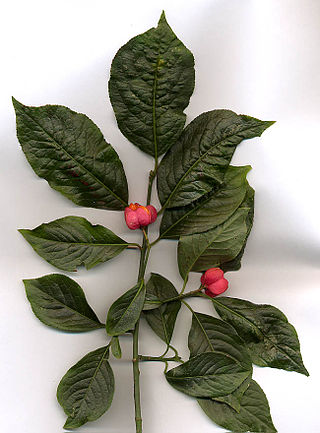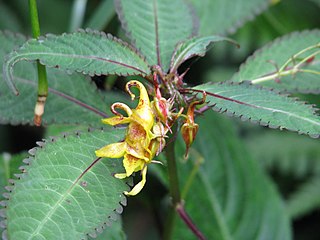
Euonymus is a genus of flowering plants in the staff vine family Celastraceae. Common names vary widely among different species and between different English-speaking countries, but include spindle, burning-bush, strawberry-bush, wahoo, wintercreeper, or simply euonymus. It has about 140 species of deciduous and evergreen shrubs, small trees and lianas. They are mostly native to East Asia, extending to the Himalayas, and they are also distributed in Europe, Australasia, North America, and Madagascar. Fifty species are endemic to China.

Magnolia wilsonii, or Wilson's magnolia, is a species of Magnolia native to China, in the provinces of western Guizhou, Sichuan and northern Yunnan, where it grows in the forest understory at altitudes of 1,900-3,000 m, rarely up to 3,300 m.

Euonymus japonicus is a species of flowering plant in the family Celastraceae, native to Japan and Korea.

Euonymus europaeus, the spindle, European spindle, or common spindle, is a species of flowering plant in the family Celastraceae, native to much of Europe, where it inhabits the edges of forest, hedges and gentle slopes, tending to thrive on nutrient-rich, chalky and salt-poor soils. It is a deciduous shrub or small tree.

Euonymus alatus, known variously as burning bush, winged euonymus, winged spindle, and winged spindle-tree, is a species of flowering plant in the family Celastraceae, native to central and northern China, Japan, and Korea.

Euonymus fortunei, the spindle, Fortune's spindle, winter creeper or wintercreeper, is a species of flowering plant in the family Celastraceae, native to east Asia, including China, Korea, the Philippines and Japan. E. fortunei is highly invasive and damaging in the United States, causing the death of trees and forest in urban areas.

Euonymus phellomanus is a species of flowering plant in the family Celastraceae, native to China. It is one of several species within Euonymus called spindle or spindle tree. A substantial deciduous shrub growing to 2–4 m (6.6–13.1 ft) tall by 2.5 m (8.2 ft) broad, it produces insignificant yellow-green flowers in May followed by brilliant pink fruits in autumn. The fruits sometimes break open to reveal bright orange seeds. A notable feature is the rough corky bark which with age develops "wings" clothing the length of each branch. A similar effect is seen in the related Euonymus alata. This feature gives rise to a name occasionally used, the corktree.

Hypericum kouytchense, the large-flowered St John's wort, is a species of flowering plant in the family Hypericaceae, native to Western China. Growing up to 3 ft (0.91 m) tall and 5 ft (1.5 m) wide, it is a semi-evergreen rounded shrub with blue-green leaves and large yellow flowers with prominent stamens, appearing in midsummer. Flowers are followed by red seed capsules in autumn. Where conditions are favourable it can retain its leaves all year.

Euonymus sachalinensis, the flat-stalked spindle, is a species of flowering plant in the family Celastraceae, native to Japan, China, Korea, and the Island of Sakhalin. Growing to 2.5 m (8.2 ft) tall and broad, it is a deciduous shrub notable for its leaves turning red in autumn, and its red fruit which splits open to reveal orange seeds. Exceptional specimens, such as the one in the Hørsholm Arboretum, Copenhagen University, can become trees up to 4 m (13 ft) in height.

Euonymus cornutus is a species of flowering plant in the genus Euonymus, native to Tibet, central China and Myanmar. Its putative variety Euonymus cornutus var. quinquecornutus, called the five‑horned spindle, has gained the Royal Horticultural Society's Award of Garden Merit.

Euonymus carnosus, called the fleshy‑flowered spindletree, is a species of flowering plant in the genus Euonymus, native to southeast and south‑central China, Taiwan, the Bonin Islands, the Ryukyu Islands, and Japan. It has gained the Royal Horticultural Society's Award of Garden Merit.

Euonymus oxyphyllus, the Korean spindle tree, is a species of flowering plant in the family Celastraceae, native to central and eastern China, Manchuria, Korea, Japan and the Kurils. It is a shrub or small tree typically reaching 2.5 m (8 ft). The Royal Horticultural Society considers it to be a good tree for smaller gardens, especially for its colorful Autumn foliage and fruits.

Rhododendron lanatum, the woolly rhododendron, is a species of flowering plant in the family Ericaceae, native to the eastern Himalayas and southeastern Tibet. Occasionally found in commerce, it is a rabbit-tolerant evergreen shrub reaching 3–10 ft (1–3 m). Hardy in USDA zones 7 through 9, it is recommended as a hedge in partly shady situations.

Indigofera amblyantha, the Chinese indigo or pink-flowered indigo, is a species of flowering plant in the family Fabaceae, native to central and southern China. A non‑climbing shrub reaching 6 ft (2 m), it blooms from May to September, and is recommended for hedges, borders, massing, and containers.

Impatiens stenantha, the narrow-flowered balsam, is a species of flowering plant in the family Balsaminaceae. It is native to Tibet, northwestern Yunnan, Nepal, the eastern Himalayas, Assam, and northern Myanmar. An annual or perennial typically reaching 40 cm (16 in), it is found in the understory of mixed forests and thickets at elevations from 2,400 to 3,000 m above sea level. It may be conspecific with Impatiens angustiflora, which is found only in Meghalaya and was also described by Hooker in 1875. It is available from garden suppliers.

Rhododendron sinofalconeri, the sinofalconer rhododendron, is a species of flowering plant in the family Ericaceae. It is native to southern Yunnan and northern Vietnam. An evergreen shrub or small tree reaching 3 to 10 m, it is typically found in mixed evergreen/deciduous forests and thickets, at elevations from 1,600 to 2,500 m above sea level. It is available from commercial suppliers, and features trusses of 15 to 20 pale yellow flowers, each 5 cm (2 in) long, and large 30 cm (12 in) leaves.

Euonymus latifolius, the broad-leaved spindle tree, is a species of flowering plant in the family Celastraceae. It is native to the Mediterranean region, south-central Europe, the Caucasus, and the Middle East as far as Iran, and it has been introduced to Ireland, Great Britain, and Belgium. A shrub with a rounded growth form reaching 2.5 to 4 m, it is typically found in shrublands, and in rocky habitats such as inland cliffs and mountain peaks. In the wild, it requires shade; too much sunlight can prove lethal. A low maintenance choice for a number of landscaping and garden applications, it is available from commercial nurseries.
Euonymus aculeatus, the prickly spindle, is a species of flowering plant in the family Celastraceae. It is native to southern China. A scrambling evergreen shrub reaching 2 to 3 m, it is typically found in forests and scrublands from 300 to 1,500 m above sea level. Valued for the visual appeal of its prickly orange fruit, it can be trained to climb up a garden wall, or be used as a ground cover.

Euonymus myrianthus, the many-flowered spindle, is a species of flowering plant in the family Celastraceae. It is native to central and southern China. A variable evergreen shrub or small tree, and reaching 3 to 12 m in height, it is typically found in wooded areas and forests, from near sea level up to 1,200 m (3,900 ft). In cultivation it does not grow much past 4 m (13 ft), and is valued for its profusion of yellow-orange fruit and scarlet arils which remain on the plant and provide winter interest. It is readily available from commercial suppliers.

Euonymus sanguineus, the blood red spindle, is a species of flowering plant in the family Celastraceae. It is native to Nepal, and to nearly all of China except Xinjiang, Manchuria, and Hainan. A deciduous shrub reaching 3 to 5 m, it is typically found in scrublands and mixed evergreen/deciduous forests, at elevations from 1,800 to 3,700 m. It may be available from specialty suppliers.


















